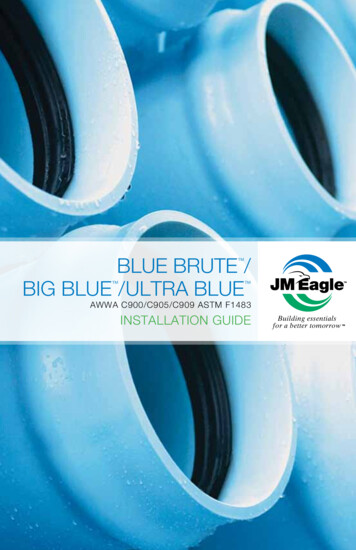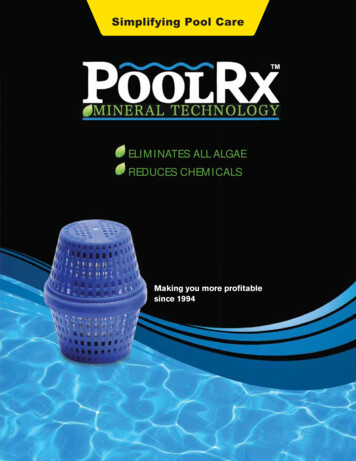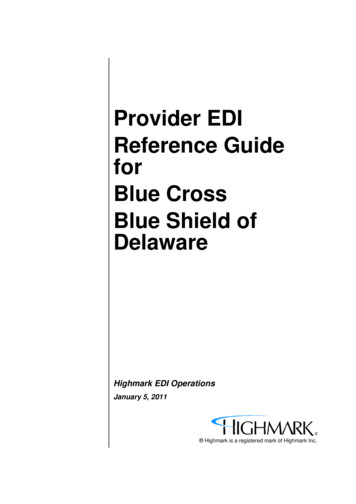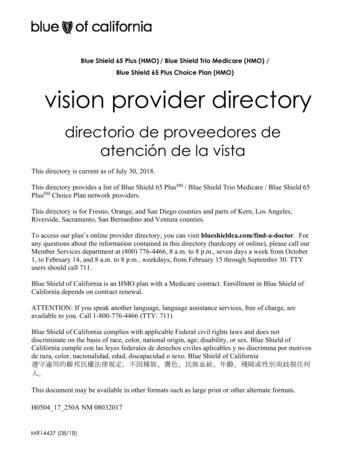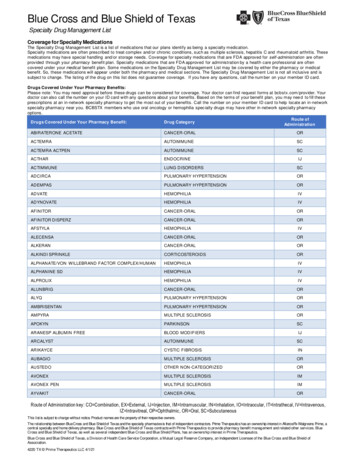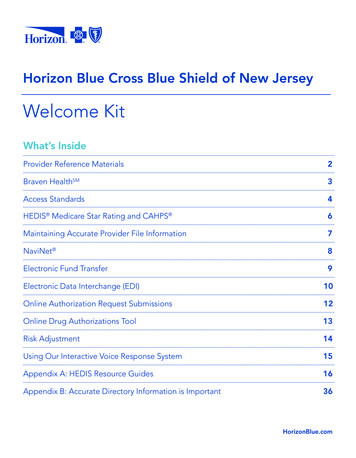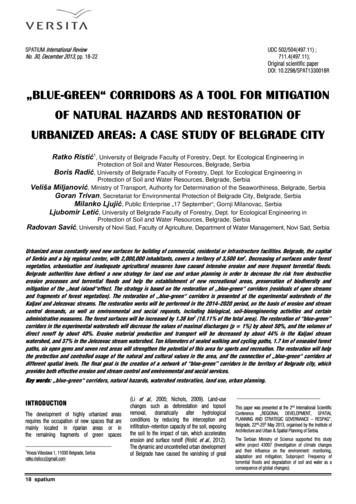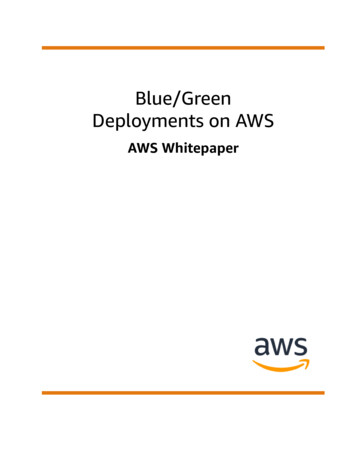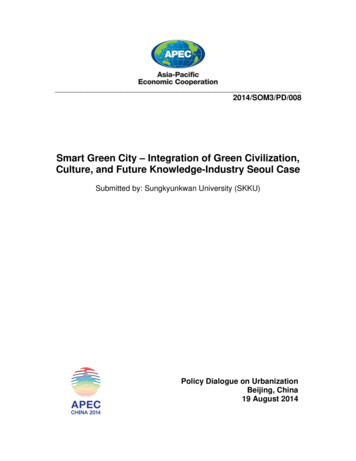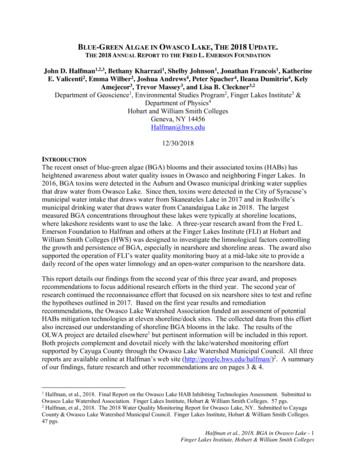
Transcription
BLUE-GREEN ALGAE IN OWASCO LAKE, THE 2018 UPDATE.THE 2018 ANNUAL REPORT TO THE FRED L. EMERSON FOUNDATIONJohn D. Halfman1,2,3, Bethany Kharrazi1, Shelby Johnson1, Jonathan Francois1, KatherineE. Valicenti2, Emma Wilber2, Joshua Andrews4, Peter Spacher4, Ileana Dumitriu4, KelyAmejecor3, Trevor Massey3, and Lisa B. Cleckner3,2Department of Geoscience1, Environmental Studies Program2, Finger Lakes Institute3 &Department of Physics4Hobart and William Smith CollegesGeneva, NY 14456Halfman@hws.edu12/30/2018INTRODUCTIONThe recent onset of blue-green algae (BGA) blooms and their associated toxins (HABs) hasheightened awareness about water quality issues in Owasco and neighboring Finger Lakes. In2016, BGA toxins were detected in the Auburn and Owasco municipal drinking water suppliesthat draw water from Owasco Lake. Since then, toxins were detected in the City of Syracuse’smunicipal water intake that draws water from Skaneateles Lake in 2017 and in Rushville’smunicipal drinking water that draws water from Canandaigua Lake in 2018. The largestmeasured BGA concentrations throughout these lakes were typically at shoreline locations,where lakeshore residents want to use the lake. A three-year research award from the Fred L.Emerson Foundation to Halfman and others at the Finger Lakes Institute (FLI) at Hobart andWilliam Smith Colleges (HWS) was designed to investigate the limnological factors controllingthe growth and persistence of BGA, especially in nearshore and shoreline areas. The award alsosupported the operation of FLI’s water quality monitoring buoy at a mid-lake site to provide adaily record of the open water limnology and an open-water comparison to the nearshore data.This report details our findings from the second year of this three year award, and proposesrecommendations to focus additional research efforts in the third year. The second year ofresearch continued the reconnaissance effort that focused on six nearshore sites to test and refinethe hypotheses outlined in 2017. Based on the first year results and remediationrecommendations, the Owasco Lake Watershed Association funded an assessment of potentialHABs mitigation technologies at eleven shoreline/dock sites. The collected data from this effortalso increased our understanding of shoreline BGA blooms in the lake. The results of theOLWA project are detailed elsewhere1 but pertinent information will be included in this report.Both projects complement and dovetail nicely with the lake/watershed monitoring effortsupported by Cayuga County through the Owasco Lake Watershed Municipal Council. All threereports are available online at Halfman’s web site (http://people.hws.edu/halfman/)2. A summaryof our findings, future research and other recommendations are on pages 3 & 4.1Halfman, et al., 2018. Final Report on the Owasco Lake HAB Inhibiting Technologies Assessment. Submitted toOwasco Lake Watershed Association. Finger Lakes Institute, Hobart & William Smith Colleges. 57 pgs.2Halfman, et al., 2018. The 2018 Water Quality Monitoring Report for Owasco Lake, NY. Submitted to CayugaCounty & Owasco Lake Watershed Municipal Council. Finger Lakes Institute, Hobart & William Smith Colleges.47 pgs.Halfman et al., 2018. BGA in Owasco Lake - 1Finger Lakes Institute, Hobart & William Smith Colleges
The Owasco Lake and watershed monitoring program supported by Cayuga County focused ontwo offshore lake sites, water grab samples from streams in the watershed, and a daily analysis ofnutrient and sediment loads from Dutch Hollow Brook to the lake. Conclusions based on thiswork include: Algal growth is limited by phosphorus in Owasco Lake.Annual mean, open-water, total phosphorus concentrations are insufficient to support theamount of phosphorus required for the BGA shoreline blooms measured to date.Estimated annual phosphorus budgets for the lake revealed larger inputs than outputs.Nonpoint sources of nutrients from, e.g., runoff from agricultural areas, roadside ditches andconstruction sites, dominated the phosphorus loads to the lake. Over 95% of the total loadswere delivered to the lake during precipitation events.Various best management practices should continue to be implemented and expanded toreduce nonpoint and point sources of nutrients, especially phosphorus, to the lake.The HABs Mitigation Technology Assessment Project supported by Owasco Lake WatershedAssociation focused on samples collected from eleven homeowner’s docks along the shoreline.Findings from this project include: BGA blooms are transitory over both space and time, i.e., spanning across short segments ofshoreline and lasting only a few hours.The BGA bloom transitory nature and potential linkages to meteorological events indicatethat an array of water quality sensors that measure, e.g., fluorescence (total and BGA),turbidity, temperature, dissolved oxygen, and meteorological sensors that measure, e.g., windspeed, wind direction, air temperature, precipitation and light intensity, should be deployed atnumerous sites to monitor these parameters every 30 minutes during the HABs season tobetter understand the limnological and atmospheric conditions associate with the appearanceand disappearance of BGA blooms.The mitigation technology assessment was inconclusive because the weekly docksidesamples never coincided with a bloom.The first year of the Emerson award focused on the limnology and sediment character at sixnearshore sites. Results include: BGA blooms favored warm, calm waters, and were detected in the late summer and earlyfall. The largest blooms were detected along the shoreline, highlighting the need to betterunderstand the nearshore environment.Additional factors to support the meteorological linkages to BGA blooms discovered in 2017require substantiation in 2018 and 2019.o Wind/Storm events released nutrients from the nearshore sediments, which in turnsupported subsequent BGA blooms in nearshore regions.o The quantity and quality of organic matter in the shoreline sediments is sufficient for thedetected bloom activity.The 2017 results prompted the HABs Mitigation Assessment Project with financial supportfrom the Owasco Lake Watershed Association.Halfman et al., 2018. BGA in Owasco Lake - 2Finger Lakes Institute, Hobart & William Smith Colleges
2018 SUMMARY, FUTURE RESEARCH & OTHER RECOMMENDATIONS:Report Highlights Annual mean shoreline BGA bloom concentrations steadily rose from 2014 through 2017,and remained at the 2017 concentrations in 2018. Many of the shoreline blooms containedhigh concentrations of toxins. In contrast, BGA concentrations at the open-water andnearshore sites surveyed by this project were much smaller than the shoreline sites, up to10,000 x’s smaller. The 2018 nearshore temperature data again revealed that surface water temperature decreasespreceded BGA blooms. This indicates that wind and/or storm events, that likely caused thetemperature decreases, could provide additional nutrients to nearshore areas by runoff fromland or sediment disturbance by waves and/or internal seiche activity, thus stimulatingnearshore BGA blooms. The actual blooms occurred on the next sunny and calm day. Laboratory experiments indicate that sediment samples placed in sunlight and incubated inalgae-free water with no added nutrient concentrations can still grow BGA blooms.Future Research The 2017 and 2018 research highlighted a number of important relationships to test in 2019.o The relationship between wind and/or storm events and the hypothesized release ofnutrients from the shoreline sediments (see dockside sensor nodes described below).o The relationship between the extent and type of macrophytes and the extent of zebra &quagga mussels at nearshore regions and the occurrence of BGA blooms. This requiresdetailed quadrant surveys of the lake-floor by SCUBA divers on multiple dates at thenearshore sites.o The bioavailability of nutrients in the sediments and the nutrient flux from the nearshoresediments to the water column, especially after sediment disturbance. This requirescollection of short sediment cores, and nutrient flux testing in the lab. Sensor arrays should be deployed at multiple dockside sites to detect the pertinent changes inthe atmosphere and the water column that are associated with BGA blooms.o At a minimum, the following meteorological and water parameters should be monitored:air temperature, light intensity, wind direction and wind speed; and water temperature,dissolved oxygen, turbidity, and fluorescence (total and BGA) at 30-munite intervals at anumber of sites around the lake. Unfortunately, nutrients are challenging to measureelectronically, and the floating nature of BGA blooms are challenging to be reliablydetected by a BGA sensor deployed in the water at a fixed depth. Lakes levels changetoo much on multiple time scales due to precipitation, waves on windy days and lakelevel control at the outlet over the course of a field season. Instead, automated camerasshould be deployed at each site to log photograph of the lake on a 30-minute basis.Periodic dockside photographs detected BGA blooms and turbid water in 2018.o Funds to purchase and deploy water quality EXO2 sondes ( 15 to 20K), andmeteorological arrays ( 5K) at a number of shoreline locations, and display the data innear real-time on the web will be pursued, as funds that remain in the Emerson award areinsufficient to support this 100,000 investment.o As an alternative, the HWS Physics Department, with support from FLI, has designedand built prototype FLI Sensor Nodes than more economically measure watertemperature, and dissolved oxygen. Other sensors can be added to this platform andinclude light intensity, phycocyanin, total chlorophyll and turbidity ( 500 to 5,000 /Halfman et al., 2018. BGA in Owasco Lake - 3Finger Lakes Institute, Hobart & William Smith Colleges
Node depending on the sensors). The current FLI Sensor Nodes are designed toperiodically measure each parameter, store the data on an SD card, and transmit the datavia cellular technologies in near real-time to a web site for display and analysis. We hopeto deploy a number of the Nodes, with automated cameras and meteorological arrays ondocks around the lake to test the BGA genesis hypothesis developed over the first twoyears of this project.Remediation Recommendations Lakeshore owners that draw drinking water from the lake need an affordable mechanism (orfinancial support) to reduce their risks from the BGA toxins. Perhaps municipal watershould be extended to lakeshore properties to reduce health risks. Extending municipalsewer around the lake is also a good idea for nutrient source reduction. Aerators, ultrasonic vibrators, benthic mats and other in-lake strategies might provide stopgap measures to reduce the extent of the BGA blooms until the nutrient loading issue isresolved. Unfortunately, the assessment of ultrasonic vibrators and aeration bubblers wereinconclusive in 2018, mainly because the eleven test sites, that always experienced largeBGA blooms in the past, never experienced a major bloom in 2018 during the weekly sampledates. Missing the few blooms in 2018 prompted the development of the FLI Sensor Nodesto continually monitor air and lake conditions. NEVER use herbicides to kill BGA because Owasco Lake is a drinking water source, andherbicides are also toxic to humans and other organisms including dogs. Nutrients should be removed from the lake, when feasible, especially from along theshoreline. For example, macrophytes should be harvested from the nearshore areas in thelate summer before they start to decay. The macrophytes and attached algae that wash upalong the shoreline should be gathered before they decompose. The BGA surface bloomsshould be vacuumed from the water before they disappear. All of the removed organicmaterial could be composted, and not allowed back into the lake. Ultimately, the nutrient loading issues in the watershed MUST be resolved so that the lake isplaced in a negative, nutrient load balance (i.e., nutrient losses must exceed nutrientadditions). A negative balance MUST be sustained for a number of years before these issueswill go away. The Cayuga County Water quality monitoring report addresses a number ofnutrient loading reduction strategies, so they are not duplicated here.Halfman et al., 2018. BGA in Owasco Lake - 4Finger Lakes Institute, Hobart & William Smith Colleges
METHODSThis project focused on the limnology and sediment character of six nearshore sites in OwascoLake. The nearshore results will be compared to: (a) offshore data provided by the water qualityand meteorological monitoring buoy, (b) identical limnological and sediment data collected attwo mid-lake, offshore sites, and (c) additional data collected at eleven homeowner docks as partof the BGA mitigation technology assessment.Site Locations: The 2018 fieldwork focused on six nearshore sites, Sites A, plus C through G(Table 1, Fig. 1). Site B, sampled in 2017, was discontinued, in favor of Site G, located justoffshore of the Owasco Yacht Club. The switch provided a third site adjacent to ashoreline/dock survey site. All six sites were sampled from May through the end of September.The survey dates increased in frequency from bi-weekly intervals at the start at the field season,to weekly surveys through July, August and September. The sample design enabled acomparison when BGA blooms were least likely and most likely to be present, and maximizedsampling during the late summer and early fall when blue-green algae blooms were most likelyto be present. The specific 2018 survey dates were: 6/5, 6/19, 7/3, 7/10, 7/24, 7/31, 8/7, 8/21,8/28, 9/4, 9/11, 9/18 and 10/3.The nearshore sites were selected based on the lake-floor morphology and the presence and/orabsence of BGA blooms in the past. The largest morphological variant along the nearshore inOwasco Lake was the extent of a shallow water shelf and its associated macrophyte and musselbeds extending from the shoreline and gently descending to depths of 3 to 5 m before steeplydescending to greater depths (Fig. 2).Table 1. Owasco Lake Site Locations and Water Depths.Site NameNearshore Sites:A – Fire Lane 20B – Wyckoff RdC – Stone School RdD – Burtis PtE – Martin PtF – Buck PtG – Yacht ClubOffshore Sites:Site 1Site 2Buoy SiteLatitudeLongitudeWater DepthAdjacent Dockside Site?42 48.69’ N42 50.61’ N42 52.01’ N42 51.89’ N42 53.64’ N42 53.35’ N42 53.23’ N76 30.92’ W76 31.58’ W76 31.98’ W76 30.96’ W76 31.59’ W76 32.65’ W76 31.23’ W2-3m2-3m2-3m2-3m4-5m2-3m5mNoNo, discontinuedNoYesYesNoYes42 52.40’ N42 49.15’ N42 50.35’ N76 31.35’ W76 30.45’ W76 30.85’ W34 m52 m49 mFieldwork: The fieldwork consisted of a CTD water quality profile, a bbe FluoroProbe profile,Secchi disk depth, vertical plankton tow (80- m mesh), and surface water samples at each site.A bottom water sample was also collected from each offshore site. The CTD electronicallymeasures water column profiles of temperature ( C), conductivity (reported as specificconductance, S/cm, a measurement proportional to salinity), dissolved oxygen (mg/L), pH,turbidity (NTUs), photosynthetic active radiation intensities (PAR, E/cm2-s), and fluorescence(a measure of chlorophyll-a, g/L) using a SeaBird SBE-25 CTD. The CTD was lowered fromthe surface to the lake floor, collecting data every 0.5 second ( 0.1 meters) along the downcast.The bbe FluoroProbe electronically measures four different algal groups based on their accessorypigments. It distinguishes among: ‘green’ algae (Chlorophyta and Euglenophyta), ‘brown’ algae(diatoms: Baccillariophyta, Chyrsophyta, and Dinophyta), ‘blue-green’ algae (Cyanophyta), andHalfman et al., 2018. BGA in Owasco Lake - 5Finger Lakes Institute, Hobart & William Smith Colleges
‘red’ algae (Cryptophyta). The bbe FluoroProbe was attached to the CTD and deployed on everyCTD cast. Phytoplankton was collected using an 80 µm mesh net towed from a depth of 20 m(or the lake floor if shallower) to the surface. The net contents were preserved in an alcoholformalin solution and enumerated to genus level back in the laboratory under a microscope.Water samples were analyzed onsite for temperature ( C), conductivity (specific conductance, S/cm), pH, dissolved oxygen (mg/L), and alkalinity (mg/L, CaCO3) using hand-held probes andfield titration kits, and analyzed back in the laboratory for total phosphorus ( g/L, P), solublereactive phosphate (SRP, g/L, P), nitrate (mg/L, N), chlorophyll-a, soluble reactive silica ( g/L,Si), and total suspended solid (mg/L) concentrations.Fig. 1. The 2018 Owasco Lake nearshore, dockside, buoy and offshore survey sites.Halfman et al., 2018. BGA in Owasco Lake - 6Finger Lakes Institute, Hobart & William Smith Colleges
One ONSET HOBO U20L-04 data logger was deployed attached to a dock leg near eachnearshore site from 6/15 through 9/20. The logger at the Yacht Club stopped recording watertemperatures on 9/16 because they took the dock out. The six loggers were programmed torecord water temperature every hour at a depth of about 1 m below the lake’s surface todetermine if any site experienced unique temperature swings from the rest of the lake.For the nearshore sampling, sediment grabsamples were collected using a ponar dredge ateach site, and a subsample from each site wasbrought back to the lab to duplicate determinesediment concentrations of total phosphorus,water, organic matter and carbonateconcentrations. Rake tosses were also completedat each site on each survey date to qualitativelydetermine the aquatic macrophyte (rooted /attached plant) assemblages, relative abundanceand potential changes over time through thesummer season.Drone Flights: Drones were flown at an altitudeof 50 m at the six nearshore and eleven docksites to investigate the extent of nearshoremacrophytes and BGA blooms (Fig. 3). Theflight height was reduced from the 100 m flownin 2017 because some of the 100 m flightsmissed the BGA blooms along the nearshoreareas. For this work, a DJI Phantom 3 Advanceddrone with a Sony EXMOR gimbaled camerawas used, which captured 12 megapixel digitalimages. Each image spanned an area of 100 by150 meters at a flight altitude of 50 m. Multiple( 15), overlapping nearshore images werecollected at each site. Flights dates were: 6/5,7/3, 7/10, 7/17, 7/24, 7/30, 8/6, 8/11, 8/20, 9/3,9/5, 9/9, 9/14, 9/16, & 9/30, plus a few additionaldates with partial site coverage due to high windsor rain. Drones collected one vertical and twooblique photos looking up and down theshoreline at the dockside sites starting on 7/30.Drones will no longer be flown in high winds( 10 mph) or in rainy weather.Fig. 2. The nearshore bathymetry. The contourinterval shown is 2 m, in shallow water ( 10m),and 10 m in deeper water. Each map was drawn atthe same scale. The two meter bathymetric contouris highlighted in red for comparison between sites.Fig. 3. The drone used in this study,a Phantom 3 Advanced by DJI.Owasco Buoy: The FLI meteorological and water quality monitoring buoy manufactured byYSI/Xylem was redeployed at its mid-lake site in 49 m of water from 4/25 through 10/29 (Table1 & Fig. 1). The buoy was programmed to collect water column profiles every 12 hours (noonand midnight) of temperature ( C), conductivity ( S/cm, reported as specific conductance),dissolved oxygen (mg/L & % saturation, by optical sensor), turbidity (NTUs by backscattering),and fluorescence measuring both total chlorophyll and blue-green algae phycocyanin (RFUs, byHalfman et al., 2018. BGA in Owasco Lake - 7Finger Lakes Institute, Hobart & William Smith Colleges
specific pigment excitation at different wavelengths of light). Data was collected every 1.5meters down the water column starting at 1 m using a YSI/Xylem EXO2 water quality sonde.The buoy also recorded five-minute mean air temperature, barometric pressure, relativehumidity, light intensity, wind speed and wind direction data every 30 minutes. Al
Halfman et al., 2018. BGA in Owasco Lake - 1 Finger Lakes Institute, Hobart & William Smith Colleges BLUE-GREEN ALGAE IN OWASCO LAKE, THE 2018 UPDATE. THE 2018 ANNUAL REPORT TO THE FRED L. EMERSON FOUNDATION John D. Halfman1,2,3, Bethany Kharrazi1, Shelby Johnson1, Jonathan Francois1, Katherine E. Val
